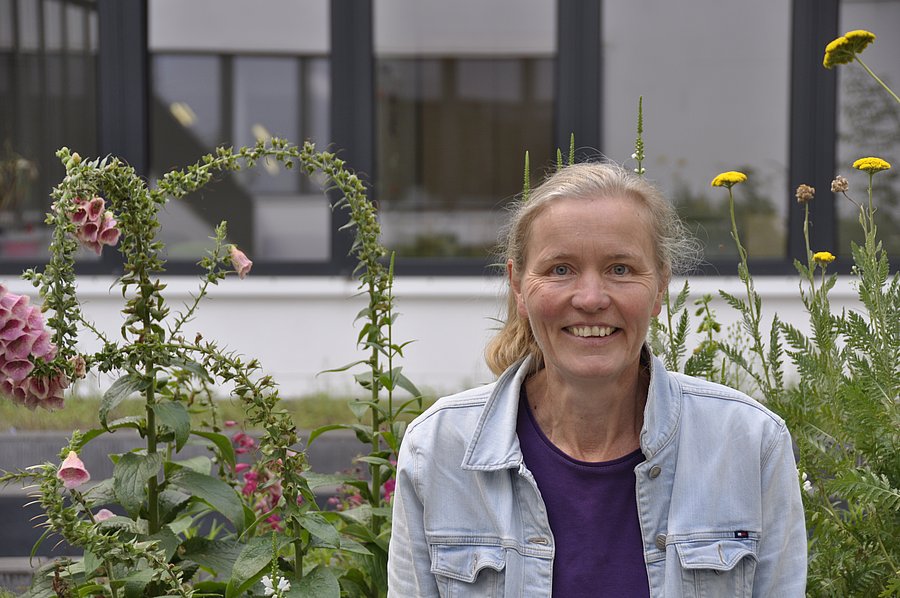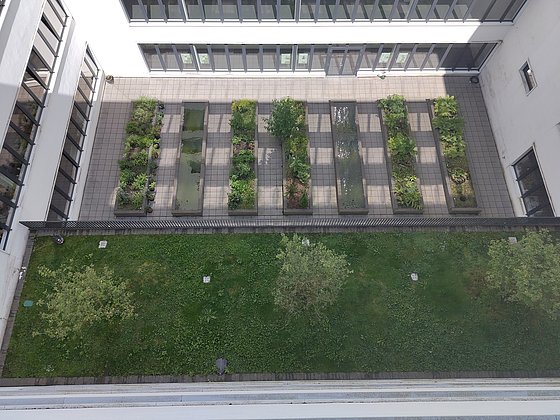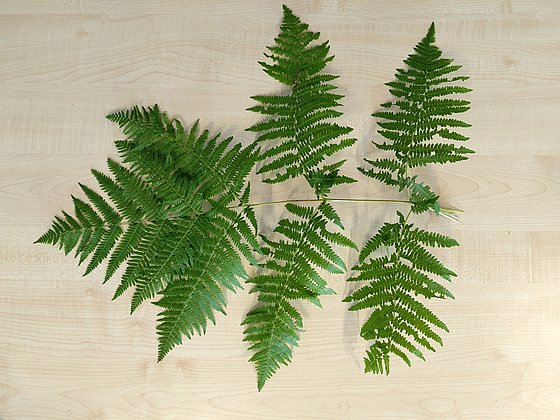
Evolution of land plants Prof. Dr Gertrud Lohaus / Botany Photo: UniService Transfer
Evolution of land plants in five plant boxes
University of Wuppertal presents plant system in the inner court of Building V
Anyone who has always been interested in the evolution of land plants can now find out how the relationships between them developed in the smallest of spaces, namely in the inner court of Building V at the University of Wuppertal. Gertrud Lohaus, professor of botany, and her colleagues have painstakingly created a plant system that she is happy to explain to interested visitors on a guided tour. "The plant system contains the systematic groups into which plant species are categorised and makes their relationships visible," she says and can explain how the development of land plants has taken place over the last 500 million years using five large plant boxes.

Planter boxes in the inner courtyard of Building V from above Photo: Gertrud Lohaus
An inner court and its challenges
After the Department of Chemistry and Biology relocated to its new premises in Gaußstraße, the botanist had the opportunity to design the inner court for botanical teaching and research. "We were able to use the plant boxes in the inner court. The conditions in this court are extremely challenging as, for example, a third of the area is in the shade of the buildings and is not suitable for many plant species. Furthermore, the soil is also unsuitable for most plant species. It therefore took a number of years before sample species were available for most of the plant families presented." In recent decades, many new insights into the relationships between plants have been gained through molecular research methods. However, a system represents merely a snapshot of the current state of knowledge. In contrast to universities with a large biology department and an associated botanical garden, which usually house a system of the plant kingdom outside, the plant system at the small but excellent biology department at the University of Wuppertal is accordingly smaller. "We have now created a system with small mosses and ferns in the shade through to sun-hungry lavender in the sunnier areas," says Lohaus happily.
"Biology students study topics such as evolution and biodiversity as well as the identification of plant species. The system can therefore also be used as an introduction to these topics. The individual plant groups are also described on posters exhibited in the corridor of building V, level 07."

Bracken fern
Photo: Gertrud Lohaus
The development of land plants began around 450 million years ago
The first land plants probably appeared in the Ordovician period, over 450 million years ago. They were related to algae. "Today," explains Lohaus, "there are four major groups: mosses, ferns, gymnosperms and angiosperms (flowering plants)." Moss-like plants were probably the earliest land plants and were the first to make the transition from water to land. Even today, they can be found in mostly damp and shady places. The fascinating thing about these plants is that after they had dried out they can absorb water again and continue to grow. The ferns often found in damp forests, which had their heyday in the Carboniferous period, around 360 million years ago, are somewhat younger. Tree ferns over 30 metres tall formed veritable swamp forests and were the raw material for hard coal. Fern-like plants were among the first land plants to have developed a system for transporting nutrients and water and were thus able to grow upwards. Like mosses, they still reproduce by spores and not by seeds. The third group, the so-called gymnosperms, still includes around 700 species that dominate the vegetation in some areas of the world, mainly conifers. Their most important phase was around 200 million years ago, when they formed huge areas of forest and were the raw material for lignite. The fourth group consists of angiosperms, which in a narrower sense can also be called flowering plants and which characterise the present day. "There are around 300,000 species worldwide. These can be divided into so-called monocotyledons (monocots) and dicotyledons (dicots). "Many species have fascinating flowers and this variety of flowers can be seen in connection with pollination by animals, e.g. insects, birds or bats. The sweet grasses (Poaceae) also belong to the monocots. This is probably the most important plant family for us humans, as the world's population's diet is largely based on cereals and here again on very few species, including rice, maize, wheat and millet species," explains Lohaus. The flowers of sweet grasses are generally not so easy to notice, as they are very reduced and wind-pollinated.
Lohaus summarised detailed information on these large groups of plants in a brochure that can be downloaded from department’s website: https://www.botanik.uni-wuppertal.de/fileadmin/biologie/botanik/Bilder/EvolutionPflanzen_Broschuere_Lohaus_UniWuppertal_20240716.pdf.
The plant system is located in the court of building V.07.
Uwe Blass
Prof. Dr Gertrud Lohaus took over the professorship for Molecular Plant Research/Plant Biochemistry at the University of Wuppertal in 2009.
